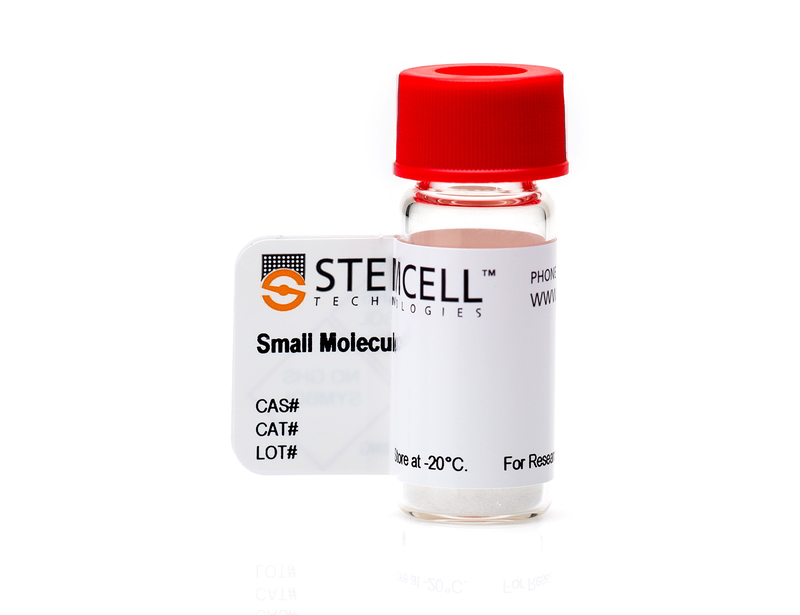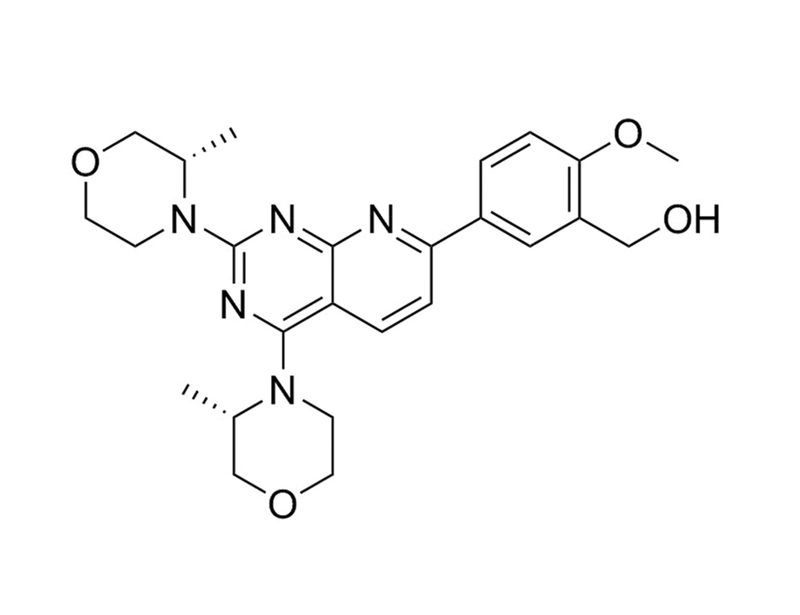概要
AZD8055 is a potent, selective ATP-competitive inhibitor of mammalian target of rapamycin (mTOR), with an IC₅₀ value of 0.8 nM (Chresta et al.). It is very specific with ~1,000-fold selectivity for mTOR over all PI3K isoforms and exhibits no activity against a panel of 260 kinases at concentrations up to 10 µM (Chresta et al.).
CANCER RESEARCH
· Inhibits proliferation of A549 and H838 small-cell lung cancer cell lines in vitro, and inhibits tumor growth from a variety of human tumor xenografts in mice after oral administration (Chresta et al.).
· Inhibits cell proliferation, increases cell death and reduces migration in tamoxifen-resistant (TamR) and estrogen deprivation-resistant (MCF7-X) breast cancer cell lines (Jordan et al.).
· Induces apoptosis and inhibits proliferation in Hep-2, a human laryngeal cancer cell line (Zhao et al.).
· In combination with ABT-737, synergistically induces apoptosis in rhabdomyosarcoma (RMS) cells by suppressing expression of myeloid leukemia cell differentiation protein (MCL1; Preuss et al.).
· Inhibits proliferation and glycolysis, and induces apoptosis, in HeLa human cervical cancer cell line (Li et al.).
CANCER RESEARCH
· Inhibits proliferation of A549 and H838 small-cell lung cancer cell lines in vitro, and inhibits tumor growth from a variety of human tumor xenografts in mice after oral administration (Chresta et al.).
· Inhibits cell proliferation, increases cell death and reduces migration in tamoxifen-resistant (TamR) and estrogen deprivation-resistant (MCF7-X) breast cancer cell lines (Jordan et al.).
· Induces apoptosis and inhibits proliferation in Hep-2, a human laryngeal cancer cell line (Zhao et al.).
· In combination with ABT-737, synergistically induces apoptosis in rhabdomyosarcoma (RMS) cells by suppressing expression of myeloid leukemia cell differentiation protein (MCL1; Preuss et al.).
· Inhibits proliferation and glycolysis, and induces apoptosis, in HeLa human cervical cancer cell line (Li et al.).
技术资料
| Document Type | 产品名称 | Catalog # | Lot # | 语言 |
|---|---|---|---|---|
| Product Information Sheet | AZD8055 | 73002, 73004 | All | English |
| Safety Data Sheet | AZD8055 | 73002, 73004 | All | English |
数据及文献
Publications (5)
Breast cancer research : BCR 2014
Impact of dual mTORC1/2 mTOR kinase inhibitor AZD8055 on acquired endocrine resistance in breast cancer in vitro.
Abstract
Abstract
INTRODUCTION: Upregulation of PI3K/Akt/mTOR signalling in endocrine-resistant breast cancer (BC) has identified mTOR as an attractive target alongside anti-hormones to control resistance. RAD001 (everolimus/Afinitor®), an allosteric mTOR inhibitor, is proving valuable in this setting; however, some patients are inherently refractory or relapse during treatment requiring alternative strategies. Here we evaluate the potential for novel dual mTORC1/2 mTOR kinase inhibitors, exemplified by AZD8055, by comparison with RAD001 in ER + endocrine resistant BC cells. METHODS: In vitro models of tamoxifen (TamR) or oestrogen deprivation resistance (MCF7-X) were treated with RAD001 or AZD8055 alone or combined with anti-hormone fulvestrant. Endpoints included growth, cell proliferation (Ki67), viability and migration, with PI3K/AKT/mTOR signalling impact monitored by Western blotting. Potential ER cross-talk was investigated by immunocytochemistry and RT-PCR. RESULTS: RAD001 was a poor growth inhibitor of MCF7-derived TamR and MCF7-X cells (IC50 ≥1 μM), rapidly inhibiting mTORC1 but not mTORC2/AKT signalling. In contrast AZD8055, which rapidly inhibited both mTORC1 and mTORC2/AKT activity, was a highly effective (P textless0.001) growth inhibitor of TamR (IC50 18 nM) and MCF7-X (IC50 24 nM), and of a further T47D-derived tamoxifen resistant model T47D-tamR (IC50 19 nM). AZD8055 significantly (P textless0.05) inhibited resistant cell proliferation, increased cell death and reduced migration. Furthermore, dual treatment of TamR or MCF7-X cells with AZD8055 plus fulvestrant provided superior control of resistant growth versus either agent alone (P textless0.05). Co-treating with AZD8055 alongside tamoxifen (P textless0.01) or oestrogen deprivation (P textless0.05) also effectively inhibited endocrine responsive MCF-7 cells. Although AZD8055 inhibited oestrogen receptor (ER) ser167 phosphorylation in TamR and MCF7-X, it had no effect on ER ser118 activity or expression of several ER-regulated genes, suggesting the mTOR kinase inhibitor impact was largely ER-independent. The capacity of AZD8055 for ER-independent activity was further evidenced by growth inhibition (IC5018 and 20 nM) of two acquired fulvestrant resistant models lacking ER. CONCLUSIONS: This is the first report demonstrating dual mTORC1/2 mTOR kinase inhibitors have potential to control acquired endocrine resistant BC, even under conditions where everolimus fails. Such inhibitors may prove of particular benefit when used alongside anti-hormonal treatment as second-line therapy in endocrine resistant disease, and also potentially alongside anti-hormones during the earlier endocrine responsive phase to hinder development of resistance.
International journal of clinical and experimental medicine 2014
mTOR inhibitor AZD8055 inhibits proliferation and induces apoptosis in laryngeal carcinoma.
Abstract
Abstract
The mammalian target of rapamycin (mTOR) kinase forms two multiprotein complexes, mTORC1 and mTORC2, which regulate cell growth, survival, and autophagy. Allosteric inhibitors of mTORC1, such as rapamycin, have been extensively used to study tumor cell growth, proliferation, and autophagy but have shown only limited clinical utility. Here, we describe AZD8055, a novel ATP-competitive inhibitor of mTOR kinase activity, against all class I phosphatidylinositol3-kinase (PI3K) and other members of the PI3K-like kinase family. The study was to determine the effect of AZD8055 on proliferation and apoptosis on Hep-2, a human laryngeal cancer cell line and to investigate the underlying mechanism(s) of action. Hep-2 cells were treated with AZD8055 for 24, 48 or 72 h. MTT was used to determine cell proliferation. Rhodamine 123 and TUNEL staining were used to determine mitochondrial membrane potential and cell apoptosis analyzed by fluorescence-activated cell sorting (FACS). Protein expressions were examined by western blotting. Treatment with AZD8055 inhibited proliferation and induced apoptosis in Hep-2 cells in a dose- and time-dependent manner. During the prolonged treatment with AZD8055, AZD8055 inhibits the mammalian target of rapamycin mTOR. Further experiments showed which signaling cascade p-4EBP1 and substrate EIF4E as well as downstream proteins were down regulated. Furthermore, our study showed that the expression profiles of various BH3-only proteins including Bid, Bad, and Bim, apoptosis regulatory protein cleaved caspase3 was up regulated in a time-dependent manner in Hep-2 cells treated with AZD8055. Thus, in vitro, AZD8055 potently inhibits proliferation and induces apoptosis in head and neck squamous cell carcinoma.
Oncology letters 2013
The mTOR inhibitor AZD8055 inhibits proliferation and glycolysis in cervical cancer cells.
Abstract
Abstract
The aim of the present study was to determine the effect of AZD8055 on proliferation, apoptosis and glycolysis in the human cervical cancer cell line HeLa and to investigate the underlying mechanism(s) of action. HeLa human cervical cancer cells were treated with 10 nM AZD8055 for 24, 48 or 72 h. MTT was used to determine cell proliferation. Annexin V/propidium iodide staining was used to determine cell apoptosis analyzed by fluorescence-activated cell sorting (FACS). Glycolytic activity was determined by measuring the activity of the key enzyme lactate dehydrogenase (LDH) and lactate production. RNA and protein expression were examined by qRT-PCR and western blotting, respectively. Treatment with AZD8055 inhibited proliferation and glycolysis, and induced apoptosis in HeLa cells in a time-dependent manner. During the prolonged treatment with AZD8055, the phosphorylation of mammalian target of rapamycin (mTOR) C1 substrates p70S6K and phosphorylation of the mTORC2 substrate Akt were deregulated, suggesting that the activity of mTOR was downregulated. Furthermore, our study showed that the expression of miR-143 was upregulated in a time-dependent manner in HeLa cells treated with AZD8055. In summary, the present study reveals a novel antitumor mechanism of AZD8055 in HeLa human cervical cancer cells.
The Journal of biological chemistry 2013
Pan-mammalian target of rapamycin (mTOR) inhibitor AZD8055 primes rhabdomyosarcoma cells for ABT-737-induced apoptosis by down-regulating Mcl-1 protein.
Abstract
Abstract
The PI3K/mammalian Target of Rapamycin (mTOR) pathway is often aberrantly activated in rhabdomyosarcoma (RMS) and represents a promising therapeutic target. Recent evaluation of AZD8055, an ATP-competitive mTOR inhibitor, by the Preclinical Pediatric Testing Program showed in vivo antitumor activity against childhood solid tumors, including RMS. Therefore, in the present study, we searched for AZD8055-based combination therapies. Here, we identify a new synergistic lethality of AZD8055 together with ABT-737, a BH3 mimetic that antagonizes Bcl-2, Bcl-xL, and Bcl-w but not Mcl-1. AZD8055 and ABT-737 cooperate to induce apoptosis in alveolar and embryonal RMS cells in a highly synergistic fashion (combination index textless 0.2). Synergistic induction of apoptosis by AZD8055 and ABT-737 is confirmed on the molecular level, as AZD8055 and ABT-737 cooperate to trigger loss of mitochondrial membrane potential, activation of caspases, and caspase-dependent apoptosis that is blocked by the pan-caspase inhibitor Z-VAD-fmk. Similar to AZD8055, the PI3K/mTOR inhibitor NVP-BEZ235, the PI3K inhibitor NVP-BKM120 and Akt inhibitor synergize with ABT-737 to trigger apoptosis, whereas no cooperativity is found for the mTOR complex 1 inhibitor RAD001. Interestingly, molecular studies reveal a correlation between the ability of different PI3K/mTOR inhibitors to potentiate ABT-737-induced apoptosis and to suppress Mcl-1 protein levels. Importantly, knockdown of Mcl-1 increases ABT-737-induced apoptosis similar to AZD8055/ABT-737 cotreatment. This indicates that AZD8055-mediated suppression of Mcl-1 protein plays an important role in the synergistic drug interaction. By identifying a novel synergistic interaction of AZD8055 and ABT-737, our findings have important implications for the development of molecular targeted therapies for RMS.
Cancer research 2010
AZD8055 is a potent, selective, and orally bioavailable ATP-competitive mammalian target of rapamycin kinase inhibitor with in vitro and in vivo antitumor activity.
Abstract
Abstract
The mammalian target of rapamycin (mTOR) kinase forms two multiprotein complexes, mTORC1 and mTORC2, which regulate cell growth, cell survival, and autophagy. Allosteric inhibitors of mTORC1, such as rapamycin, have been extensively used to study tumor cell growth, proliferation, and autophagy but have shown only limited clinical utility. Here, we describe AZD8055, a novel ATP-competitive inhibitor of mTOR kinase activity, with an IC50 of 0.8 nmol/L. AZD8055 showed excellent selectivity (approximately 1,000-fold) against all class I phosphatidylinositol 3-kinase (PI3K) isoforms and other members of the PI3K-like kinase family. Furthermore, there was no significant activity against a panel of 260 kinases at concentrations up to 10 micromol/L. AZD8055 inhibits the phosphorylation of mTORC1 substrates p70S6K and 4E-BP1 as well as phosphorylation of the mTORC2 substrate AKT and downstream proteins. The rapamycin-resistant T37/46 phosphorylation sites on 4E-BP1 were fully inhibited by AZD8055, resulting in significant inhibition of cap-dependent translation. In vitro, AZD8055 potently inhibits proliferation and induces autophagy in H838 and A549 cells. In vivo, AZD8055 induces a dose-dependent pharmacodynamic effect on phosphorylated S6 and phosphorylated AKT at plasma concentrations leading to tumor growth inhibition. Notably, AZD8055 results in significant growth inhibition and/or regression in xenografts, representing a broad range of human tumor types. AZD8055 is currently in phase I clinical trials.

 网站首页
网站首页





